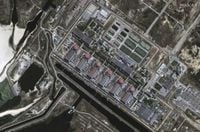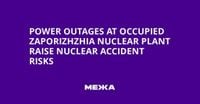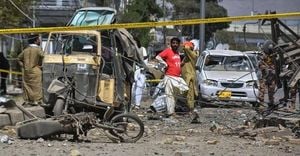The Zaporizhzhia Nuclear Power Plant, Europe’s largest nuclear facility, finds itself at the center of a mounting crisis that has drawn alarm from experts, government officials, and international agencies. For the seventh consecutive day, the plant—located in Russian-occupied southeastern Ukraine—has been operating entirely on backup diesel generators after being disconnected from the main electrical grid. This unprecedented emergency, which began on September 23, 2025, is the longest blackout the plant has experienced since the start of the war, and experts warn that the situation grows more perilous with each passing day.
Ukrainian President Volodymyr Zelenskyy did not mince words in his evening video address on September 30. As reported by Ukrinform and echoed across several outlets including UNN and RBC Ukraine, Zelenskyy stated, “Already for the seventh day—and this has not happened before—there is an emergency at the Zaporizhzhia Nuclear Power Plant. The situation is critical. Due to Russian attacks, the plant is disconnected from power, from the electrical grid.” He went on to reveal a troubling development: “We already have information that one of the generators is malfunctioning.”
The plant’s reliance on diesel generators is, in itself, a violation of safe operating conditions. According to The New York Times, while the loss of external power does not pose an immediate risk of a meltdown or explosion—since all six reactors have been shut down since September 2022—it does strip away vital layers of safety. The cooling systems, which are essential to prevent the nuclear fuel from overheating, are now dependent on emergency power supplies that were never designed for prolonged use. “The generators and the plant are not designed for this and have never operated in this mode for such a long time,” Zelenskyy emphasized, highlighting the extraordinary nature of the emergency.
The blackout was precipitated by the failure of the last high-voltage power line connecting the plant to Ukraine’s grid, in an active combat zone. The Guardian and The New York Times report that blame for the damage is hotly contested: Russia claims Ukrainian artillery severed the line, making repairs too dangerous, while Ukraine accuses Russia of deliberately engineering the crisis. Ukrainian officials argue that Moscow is seeking to justify connecting the plant to the Russian power grid, a move that could have significant geopolitical repercussions and shift the balance of power in any future peace negotiations.
As if the technical vulnerabilities weren’t enough, the plant’s staff are working under extreme duress. According to The New York Times, they have faced intimidation and even alleged torture. The plant’s main source of cooling water was lost in 2023 after a dam explosion, forcing a switch to a smaller cooling pond and wells—yet another layer of risk in an already precarious situation.
Nuclear energy experts have repeatedly sounded the alarm. Olha Kosharna, cited by rdcentre.com.ua, noted that this is the tenth blackout at Zaporizhzhia since the start of the Russian occupation. The absence of both the main 750 kV and backup 330 kV power lines has left the facility dangerously dependent on emergency diesel generators. “Prolonged reliance on diesel generators could lead to emergency situations with high risks to the reactor’s active zone and the population,” warned Oleh Dudar, a nuclear expert. The diesel fuel reserves for these generators are unknown, raising further concerns about how long the plant can safely operate in this mode.
The head of Ukraine’s State Nuclear Regulatory Inspectorate, Oleh Korikov, has echoed these concerns, warning that ignoring nuclear safety requirements and attacks on power lines may lead to events under the worst-case scenario. “Such a situation could lead to the worst-case scenario,” Korikov said, underscoring the gravity of the risks involved.
International attention has turned sharply to the crisis. On September 25, Russian President Vladimir Putin met with Rafael Grossi, Director General of the International Atomic Energy Agency (IAEA), to discuss the situation. While Grossi described the conversation as timely and important, no concrete decisions were announced regarding the plant’s stewardship. Meanwhile, Ukrainian Foreign Minister Andrii Sybiha met with Grossi and called for the “only realistic option”—a temporary transfer of stewardship to the IAEA. “The world cannot allow this,” Sybiha told Reuters, emphasizing the need for urgent international intervention.
Despite the gravity of the situation, Ukrainian management and Energoatom representatives have yet to formally request increased international pressure regarding the blackout, according to rdcentre.com.ua. Oleh Dudar criticized this inaction, stating, “If the national operator stays silent, if the national regulator stays silent, then everything is fine. And the Russians also say nothing, because this suits them; they do their business, they fully control the situation, and this is unacceptable.”
The broader context is equally troubling. UN Secretary-General António Guterres has highlighted the humanitarian crises and nuclear threats facing Ukraine, citing over 40,000 civilian deaths and 36,000 injuries since the start of the conflict. The Zaporizhzhia plant’s ongoing emergency is just one facet of a war that has repeatedly put nuclear infrastructure at risk. Since Russian forces captured the plant in March 2022, it has been on the front line, with repeated shelling and sabotage—culminating in this latest, most protracted blackout.
Experts like Bruno Chareyron, scientific adviser to the French nonprofit Commission for Independent Research and Information on Radioactivity, have warned against complacency. “The problem is, with this war, people get used to it,” Chareyron told The New York Times. “It’s very dangerous that people are used to a situation that is absolutely not normal for the operation of a nuclear power plant.”
As the days tick by, the world watches anxiously. The IAEA has stated that diesel generators can only keep the reactors cool for about ten days. With one generator already down and the fuel reserves uncertain, the margin for error is razor-thin. President Zelenskyy has instructed the Ukrainian government—specifically the Ministry of Energy and the Ministry of Foreign Affairs—to draw maximum international attention to the crisis. In his words, “No terrorist in the world has ever allowed themselves to do with a nuclear power plant what Russia is doing now. And it is right that the world should not remain silent.”
With control of Europe’s largest nuclear facility hanging in the balance, and the threat of catastrophe looming ever closer, the Zaporizhzhia crisis stands as a stark reminder of the dangers posed when war and nuclear technology collide. The coming days will be critical, as the international community grapples with how to prevent a disaster that could have consequences far beyond Ukraine’s borders.






